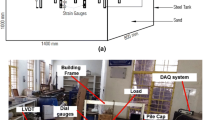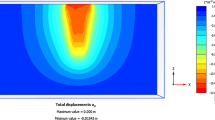Abstract
Conventional analysis of building frames will be made by assuming the bases to be rigid or hinged, whereas buildings rest on soil which allows the bases to displace and rotate. This paper presents the results of static vertical load tests carried out on model building frame supported on pile groups embedded in sand. The experimental results of displacements due to the applied loads on the experimental model have been modeled mathematically, and relevant equations have been developed. The developed equations show very good correlation coefficient which implies that the equations developed can be used to get output obtained from the experiment with fairly well with that of experiments. The present research is an attempt to model the experimental results of various displacements, viz. lateral, vertical, and rotational displacements in case of a building frame resting on group of piles embedded in sand. The developed equations can be utilized as a means to replace the experiment conducted in the laboratory with that of mathematical equations within the limitation of experimental inputs.
Access provided by Autonomous University of Puebla. Download conference paper PDF
Similar content being viewed by others
Keywords
1 Introduction
The design of any building frame by structural engineers is a challenging task due to loads and also soil interaction. The soil interaction is a difficult parameter to estimate. An attempt has been made in the present study, to determine the displacements by an experiment and also to model it mathematically for various loads applied experimentally. Soil settlement is a function of the flexural rigidity of the superstructure. The structural stiffness can have a significant influence on the distribution of the column loads and moments transmitted to the foundation of the structure. Previous studies have, however, indicated that the effect of interaction between soil and structure can be quite significant.
In this regard, much of analytical work has been reported on the building frames founded on pile groups by Ingle and Chore [1] and Chore et al. [2, 3]. But no significant study has been made in the direction of experimental investigation of the effect of soil interaction on building frames founded on pile groups except by Reddy and Rao [4,5,6]. The aim of this paper is to present the experimental investigation as well as mathematical modeling. An attempt is made to model the experimental results of various displacements, viz. lateral, vertical, and rotational displacements in case of a building frame resting on group of piles embedded in sand. The experimentally obtained results were modeled to determine the relationship between load applied and the displacements at the base of the columns in the building frame.
2 Experimental Program
2.1 Frame and Pile Groups
Using the scaling law given by Eq. (1) proposed by Wood et al. [7], the material and dimensions of model were selected. An aluminum tube with outer diameter 16 mm and inner diameter 12 mm is selected as the model pile with a length scaling factor of 1/10. This is used to simulate the prototype pile of 350 mm diameter solid section made of reinforced concrete with a compressive strength of 30 MPa. Columns of height 3.2 m and beam of span 5 m of the plane frame were scaled in the same manner. Aluminum plates of 13 mm thickness were used as pile caps. In the pile group setup, pile spacing of eight diameter (8D) is adopted, and the length of the piles is so selected to maintain length to diameter (L/D) ratio of 20 [8]. The sufficient free-standing length was maintained from the bottom of the pile cap to top of the soil bed. Beam column junctions are made by welding for the fixed condition. Screwing of piles and columns in the threads provided in the pile cap leads to partial fixed condition. The scaling factors used in the study are presented in Table 1.
where Em is modulus of elasticity of model, Ep is modulus of elasticity of prototype, Im is moment of inertia of model, Ip is moment of inertia of prototype, and 1/n is scale factor for length.
2.2 Experimental Setup and Instrumentation
The photograph of the test setup is shown in Fig. 1. Different tests were conducted on model pile groups with frame embedded in sand bed in a concrete testing chamber which is well instrumented with the dial gauges of sensitivity 0.002 to study the lateral, vertical displacements and rotations at the base of the column. Loads on the frame are applied through the hooks provided to the beam at required locations according to the type of load on the beam. The model frame was placed at the center of the testing chamber using templates. The sand is poured in the testing chamber gently through the pores of a steel tray in layers to attain the loose state and uniformity for the sand bed. The installation procedure simulates the bored pile condition.
2.3 Test Procedure
Static vertical loads were applied on the model frame by placing weights on hangers. The loads were applied in increments and were maintained for a minimum period to allow the deflection to stabilize. During the application of static loads, the lateral, vertical displacements at the base of the column and rotation of pile cap were measured using the instrumentation setup as described earlier.
3 Mathematical Modeling of Experiment
Figure 2 shows the relationship between the loads applied in the experimental setup and the vertical displacements at the base of the column measured from the experiment. The horizontal displacement is also shown in Fig. 2. From the figure, it can be seen that there is nonlinear relationship and is following a polynomial variation of order two. The developed relationship between load and vertical displacement is given in Eq. (2). The developed equation shows very good correlation of 0.9977. The developed relationship between load and horizontal displacements is given in Eq. (3). The developed equation shows very good correlation of 0.9972. Hence, the developed equations can be used to compute the displacements when a particular load is applied on the frame within the limits of experimental input.
where y is vertical displacement at the base of the column; x is load applied on the frame.
where y is horizontal displacement at the base of the column; x is load applied on the frame.
Figure 3 shows the relationship between the loads applied in the experimental setup and the rotation at the base of the column obtained from the experiment. The relationship between the load and rotation at the base of the column is following polynomial variation of order two. The developed relationship between load and rotation at the base of the column is given in Eq. (4). The developed equation shows very good correlation of 0.9991. Hence, the developed equation can be used to compute the rotation at the base of the column when a particular load is applied within the limits of experimental input.
where y is rotation at the base of the column; x is load applied on the frame.
4 Conclusions
Based on the experimental results obtained from building frame supported on pile groups embedded in cohesion-less soil, the following conclusions have been drawn:
-
An experimental study was successfully conducted in laboratory to model the building frame resting on pile groups embedded in sand based on Wood et al.’s scaling factors.
-
The lateral displacement, settlement, and rotation at the base of the column were obtained from the experiment by direct measurement.
-
The relationship between load and vertical displacement at the base of the column modeled indicates nonlinear relation with correlation of 0.9977. Similarly, the relation between load and horizontal displacement at the base of the column indicates a nonlinear relation with a correlation of 0.9972.
-
The relation between load and rotation at the base of the column indicates a nonlinear relation with a correlation of 0.9991.
-
The present research will be useful as a tool to simulate the laboratory experiment within the limits of experimental input, i.e., load to compute horizontal displacement, vertical displacement, and rotation at the base of the column from the experiment.
References
Ingle, R. K., & Chore, H. S. (2007). Soil-structure interaction analysis of building frames—An overview. Journal of Structural Engineering SERC, 34(5), 201–209.
Chore, H. S., Ingle, R. K., & Sawant, V. A. (2009). Building frame-pile foundation-soil interactive analysis. Interaction and Multiscale Mechanics, 2(4), 397–411.
Chore, H. S., Ingle, R. K., & Sawant, V. A. (2010). Building frame—Pile foundation—Soil interaction analysis: A parametric study. Interaction and Multiscale Mechanics, 3(1), 55–79.
Reddy, C. R. K., & Rao, T. D. G. (2011). Experimental study of a modeled building frame supported by pile groups embedded in cohesionless soil. Interaction and Multiscale Mechanics, 4(4), 321–336.
Reddy, C. R. K., & Rao, T. D. G. (2012). Study of soil interaction in a model building frame with plinth beam supported by pile group. International Journal of Advanced Structural Engineering, 4(11).
Reddy, C. R. K., & Rao, T. D. G. (2014). Effect of rigidity of plinth beam on soil interaction of modeled building frame supported on pile groups. Civil Engineering Dimension, 16(1), 8–17.
Wood, D. M., Crew, A., & Taylor, C. (2002). Shaking table testing of geotechnical models. International Journal of Physical Modelling in Geotechnics, 1, 1–13.
Chandrasekaran, S. S., & Boominadhan, A. (2010). Group interaction effects on laterally loaded piles in clay. Journal of Geotechnical and Geoenvironmental Engineering ASCE, 136, 573–582.
Author information
Authors and Affiliations
Corresponding author
Editor information
Editors and Affiliations
Rights and permissions
Copyright information
© 2020 Springer Nature Singapore Pte Ltd.
About this paper
Cite this paper
Ravi Kumar Reddy, C., Ramesh, K., Srinivasulu, G., Mohan Krishna, N.V. (2020). Mathematical Modeling of Displacements in Building Frame Founded on Pile Groups Embedded in Sand. In: Saride, S., Umashankar, B., Avirneni, D. (eds) Advances in Geotechnical and Transportation Engineering . Lecture Notes in Civil Engineering, vol 71. Springer, Singapore. https://doi.org/10.1007/978-981-15-3662-5_16
Download citation
DOI: https://doi.org/10.1007/978-981-15-3662-5_16
Published:
Publisher Name: Springer, Singapore
Print ISBN: 978-981-15-3661-8
Online ISBN: 978-981-15-3662-5
eBook Packages: EngineeringEngineering (R0)







